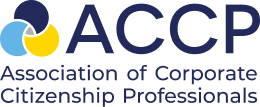By Nikki Korn, Chief Strategy Officer + Mark Feldman, Managing Director, Cause Consulting
Corporate social impact and philanthropy professionals are being challenged more than ever before to architect new, and enhance existing social impact initiatives. Signature programs – ownable, branded and outcome-driven social impact initiatives that deliver on business and social objectives – are coming of age.
We were thrilled to host a Learning Lab at this year’s ACCP Conference to talk about how to make signature programs work harder. Aligning with business strategy, engaging employees, and identifying a unique social impact opportunity are among the many common challenges practitioners face in developing master strategies and operational approaches to take their initiatives to the next level.
During the Learning Lab we covered a lot of ground in a short period of time. Most importantly, we asked everyone to take a step back and be deliberate about the process they use to drive change. We emphasized that the time is now to think bigger, to be bolder and to move beyond traditional practices. Here are few of the key takeaways emphasized during the session:
- Build from brand purpose and DNA. Know your brand promise and corporate purpose, and decide what elements your signature program should reinforce. Engage regularly with your brand team colleagues to collectively craft how to “bring to life” what you stand for.
- Focus on a relevant, critical issue. So when we say focus, we mean focus!Identify a social issue (not three) that is not only important to society and your key stakeholders, but one that makes sense for your company to rally behind over the long-term. Engage issue experts, nonprofit partners and employees to develop a “theory of change” model, align your company’s assets and architect the path forward.Then, allocate appropriate resources – this could be as much as 70-to-80% of your budget and time.
- Leverage what you do best. Get smarter and uncover the products, services processes and technologies that truly drive your company’s success. Take the time to understand your workforce’s skill sets. Then align these assets with your “theory of change.” This will help you identify your program’s “special sauce” and marketplace differentiation.
- Focus your strategic investments in fewer impact-driven partnerships. It is time to move beyond spreading resources thin across many nonprofits and communities. This approach will not move the needle on critical issues.Proactively explore deeper, longer-term, multi-layered partnerships. Ongoing collaboration is essential with players who share a common goal. Consider new and unexpected partners. And, if your current partners are not open to new ideas and change, perhaps they are not right at this time.
- Be an issue leader. Your company’s brand, voice and leadership are needed. Whether it’s to raise awareness of an issue, mobilize people to take action or convene a conversation to identify new solutions, be proactive in taking on opportunities to lead.
- Craft stories of impact. We appreciate the need to track outputs such as volunteer hours or pounds of food donated, but we must move our communications towards highlighting human outcomes and telling emotionally compelling stories.
Signature Program development and refinement is a continuous improvement journey. Following these strategies can help guide a thoughtful, deliberate approach and enable you to rally your most important stakeholders to drive together toward impact.
Nikki Korn and Mark Feldman are Principals of Cause Consulting, a social impact strategy and communications firm dedicated to simultaneously strengthening business and impacting society. This blog has been adapted from Cause Consulting’s Learning Lab at the Association for Corporate Citizenship Professionals (ACCP) Annual Conference in March 2018.
